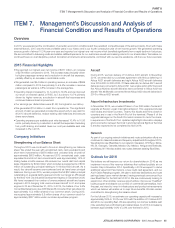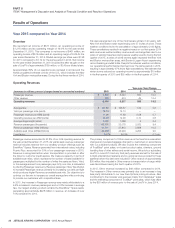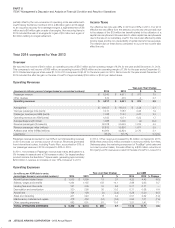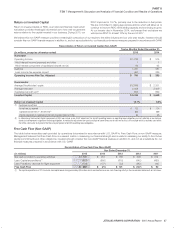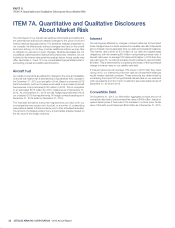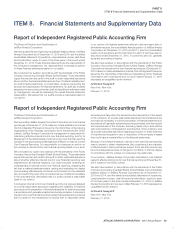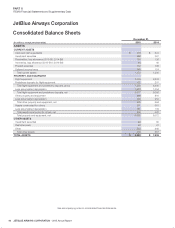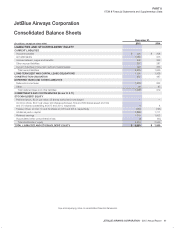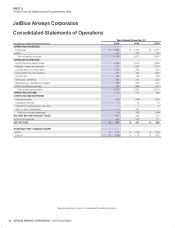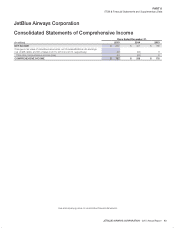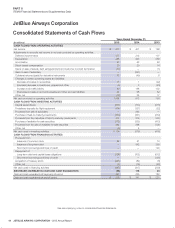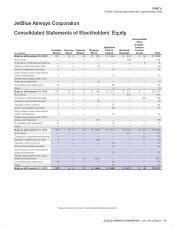JetBlue Airlines 2015 Annual Report Download - page 39
Download and view the complete annual report
Please find page 39 of the 2015 JetBlue Airlines annual report below. You can navigate through the pages in the report by either clicking on the pages listed below, or by using the keyword search tool below to find specific information within the annual report.JETBLUE AIRWAYS CORPORATION-2015Annual Report 35
PART II
ITEM7Management’s Discussion and Analysis of Financial Condition and Results of Operations
we expect to be redeemed. This liability was $24 millionas of December31,
2015 and 2014. The estimated cost includes incremental fuel, insurance,
passenger food and supplies, in-flight entertainment and reservation costs.
We adjust this liability, which is included in air traffic liability, based on points
earned and redeemed, points that will ultimately go unused, or breakage,
changes in the estimated incremental costs associated with providing travel
and changes in the TrueBlue
®
program. Customers earn points based on
the value paid for a trip rather than the length of the trip and never expire. In
addition, there is no longer an automatic generation of a travel award once
minimum award levels are reached, but instead the points are maintained
in the account until used by the member. Customers can pool points
between small groups of people, branded as Family PoolingTM. We believe
Family PoolingTM did not have a material impact on the annual breakage
calculation. Periodically we evaluate our assumptions for appropriateness,
including comparison of the cost estimates to actual costs incurred as
well as the expiration and redemption assumptions to actual experience.
Changes in the minimum award levels or in the lives of the awards would
also require us to reevaluate the liability, potentially resulting in a significant
impact in the year of change as well as in future years.
TrueBlue
®
points can also be sold to participating companies, including
credit card and car rental companies. These sales are accounted for as
multiple-element arrangements, with one element representing the fair value
of the travel that will ultimately be provided when the points are redeemed
and the other consisting of marketing related activities we conduct with
the participating company. The fair value of the transportation portion of
these point sales is deferred and recognized as passenger revenue when
transportation is provided. The marketing portion, which is the excess of
the total sales proceeds over the estimated fair value of the transportation
to be provided, is recognized in other revenue when the points are sold.
TrueBlue
®
points sold to participating companies which are not redeemed
are recognized as revenue when management determines the probability
of redemption is remote. Deferred revenue was $181 million and $162
million at December31, 2015 and 2014, respectively.
Accounting for long-lived assets
In accounting for long-lived assets we make estimates about the expected
useful lives, projected residual values and the potential for impairment. In
estimating useful lives and residual values of our aircraft, we have relied
upon actual industry experience with the same or similar aircraft types and
our anticipated utilization of the aircraft. Changing market prices of new
and used aircraft, government regulations and changes in our maintenance
program or operations could result in changes to these estimates. Changes
in expected useful lives of certain assets have resulted in an additional $13
million of depreciation and amortization expense during 2014.
Our long-lived assets are evaluated for impairment at least annually or when
events and circumstances indicate the assets may be impaired. Indicators
include operating or cash flow losses, significant decreases in market
value or changes in technology. As our assets are all relatively new and
we continue to have positive operating cash flows, we have not identified
any significant impairment related to our long-lived assets at this time.
Intangible assets
Our intangible assets consist of acquired take-off and landing Slots at
certain domestic airports. Slots are rights to take-off or land at a specific
airport during a specific time period during the day and are a means by
which airport capacity and congestion can be managed. The Federal
government controls Slots at four domestic airports under the High Density
rule, including Reagan National Airport in Washington D.C. and LaGuardia
and JFK Airports in New York City. In accounting for our Slot-related
intangible assets we make estimates about their expected useful lives. In
December 2013, due to regulatory and market activities stemming from
the auctioning of slots at LaGuardia and Reagan National airports, we
reassessed the useful lives of these assets and concluded that Slots at
High Density Airports are indefinite lived intangible assets and will no longer
amortize them. Slots at other airports will continue to be amortized on a
straight-line basis over their expected useful lives of up to 15 years. We
incurred amortization expense of $5 million in 2013 for Slots at High Density
Airports. Changes in our operations, government regulations or demand
for air travel at these airports could result in changes to these estimates.
We evaluate our intangible assets for impairment at least annually or when
events and circumstances indicate they may be impaired. Indicators
includeoperating or cash flow losses as well as significant decreases in
market value.
Lease accounting
We operate airport facilities, office buildings and aircraft under operating
leases with minimum lease payments. We recognize the costs associated
with these agreements as rent expense on a straight-line basis over the
expected lease term. Within the provisions of certain leases there are
minimum escalations in payments over the base lease term. There are
also periodic adjustments of lease rates, landing fees, and other charges
applicable under such agreements, as well as renewal periods. The
effects of the escalations and other adjustments have been reflected in
rent expense on a straight-line basis over the lease term. This includes
renewal periods when it is deemed to be reasonably assured at the
inception of the lease that we would incur an economic penalty for not
renewing. The amortization period for leasehold improvements is the term
used in calculating straight-line rent expense or their estimated economic
life, whichever is shorter.
Derivative instruments used for aircraft fuel
We utilize financial derivative instruments to manage the risk of changing
aircraft fuel prices. We do not purchase or hold any derivative instrument
for trading purposes. As of December31, 2015, we had a net $5 million
liability related to the net fair value of these derivative instruments; the
majority of which are not traded on a public exchange. Fair values are
determined using commodity prices provided to us by independent third
parties. When possible, we designate these instruments as cash flow hedges
for accounting purposes, as defined by the Derivatives and Hedging topic
of the Codification which permits the deferral of the effective portions of
gains or losses until contract settlement.
The Derivatives and Hedging topic is a complex accounting standard. It
requires us to develop and maintain a significant amount of documentation
related to:
(1) our fuel hedging program and fuel management approach.
(2) statistical analysis supporting a highly correlated relationship between
the underlying commodity in the derivative financial instrument and the risk
being hedged, i.e. aircraft fuel, on both a historical and prospective basis.
(3) cash flow designation for each hedging transaction executed, to be
developed concurrently with the hedging transaction.
This documentation requires us to estimate forward aircraft fuel prices
since there is no reliable forward market for aircraft fuel. These prices are
developed through the observation of similar commodity futures prices,
such as crude oil and/or heating oil, and adjusted based on variations to
those like commodities. Historically, our hedges have settled within 24
months; therefore, the deferred gains and losses have been recognized
into earnings over a relatively short period of time.


